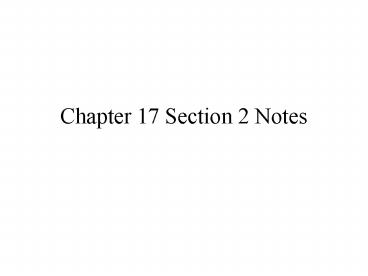Chapter 17 Section 2 Notes PowerPoint PPT Presentation
Title: Chapter 17 Section 2 Notes
1
Chapter 17 Section 2 Notes
2
Intro 1.In the 1400s northern Europeans began
to adopt the ideas of the Renaissance.2.
Renaissance ideas such as the importance of the
individual are a strong part of modern thought
3
I. The Northern Renaissance Begins
4
A. By 1453 cities in northern Europe were
recovering from the Bubonic Plague and the
Hundred Years Wars between England and France
5
B. Flanders (Belgium) is where the Northern
Renaissance began
6
C. Rulers in France and England helped spread the
Renaissance to those countries
7
1. Francis I sponsored the arts in France
8
D. Northern Renaissance humanist developed plans
for social reform based on Christian beliefs
9
II. Artistic Ideas Spread
10
A. In 1494 France goes to war with Italy and many
Italian artists fled to Northern Countries
11
B. German Painters
12
1. Albrecht Durer
13
Pond in the Woodsc. 1496Watercolor and gouache
on paper26 x 37 cmBritish Museum, London
The Four Horsemen of the Apocalypse1498Woodcut3
9 x 28 cm
14
a. Woodcuts and engravings of religion and
classical myths
15
2. Hans Holbein the Younger
16
Henry VIII
17
a. Royal family portraits with photographic
detail
18
1. King Henry VIII
19
C. Flemish Painters ( Individuals and worldly
pleasures)
20
1. Jan van Eyck
21
Man in a Red Turban
22
a. Invented oil paints
23
b. Revealed personality of subjects
24
2. Pieter Bruegel the Elder
25
The Harvesters
The Beggars
Peasant wedding
26
a. Captured scenes of everyday peasant life
ltgt
27
1. Weddings, dances, and harvests
28
D. Dutch Painters
29
1. Rembrandt Van Rijn
30
(No Transcript)
31
(No Transcript)
32
a. Considered the Dutch Master
33
III. Northern Writers Try to Reform Society
34
A. Writers adopt the Renaissance ideas of
humanism
35
1. Some gave it a religious slant became known as
Christian humanists
36
B. Christian Humanists
37
1. Desiderius Erasmus (Holland)
38
a. 1509 writes the book The Praise of Folly
39
1. Poked fun at greedy merchants, quarrelsome
scholars,and pompous priests
40
b. Believed in Christianity of the heart not
ceremonies
41
2. Sir Thomas More (England)
42
a. 1516, writes the book Utopia
43
1. About an imaginary land inhabited by
peace-loving people where greed, corruption, war,
and crime had been weeded out
44
C. French Humanist
45
1. Francois Rabelais (France)
46
a. Wrote comic adventure Gargantua and Pantagruel
47
1. About two giants that traveled through France
48
2. Poked fun at society, education, and
government
49
D. William Shakespeare (English)
50
1. Greatest playwright of all time, command of
English language, and understanding of human
beings
51
2. Scenes of dramatic conflict, tragedies
52
3. Works include, Macbeth, King Lear, Hamlet, A
Midsummer Nights Dream, Romeo and Juliet, and
Julius Caesar
53
E. The Elizabethan Age
54
1. Named after Queen Elizabeth I 1558-1603
55
2. She spoke English, French, Italian, Latin, and
Greek
56
IV. Printing Spreads Renaissance Ideas
57
A. Gutenberg invents the Printing Press
Only
46 copies of the Gutenberg Bible still exist in
the world. Because of this, each copy is
considered priceless. A part of a page is shown
above right.
58
1. Johann Gutenberg, from Mainz, Germany invents
movable type inEurope in 1440
59
2. His first book was the Gutenberg Bible in 1445
60
B. Printing Spreads Learning
61
1. Books became cheaper because more were being
printed
62
2. New ideas spread quick
63
3. Literacy arose
64
4. Vernacular language helped those that couldnt
afford a classical education
65
(No Transcript)
66
1 B
2 H

